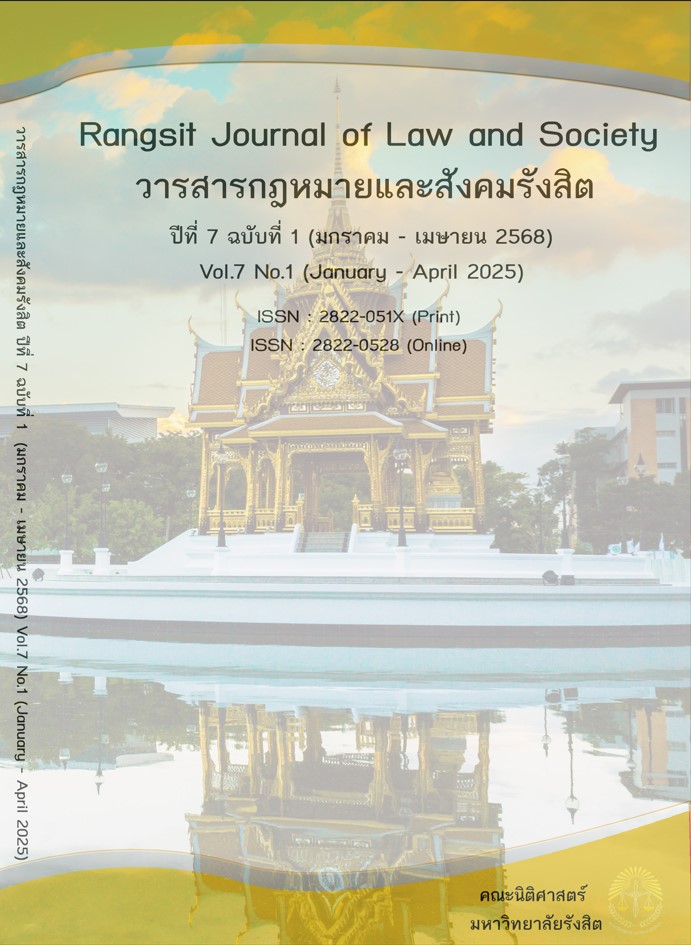มาตรการทางกฎหมายในการลดอันตรายของแอลกอฮอล์ต่อมนุษย์
Main Article Content
บทคัดย่อ
บทความนี้นำเสนอเกี่ยวกับอันตรายของแอลกอฮอล์ต่อมนุษย์และอันตรายทางกฎหมาย จากปัญหาการดื่มแอลกอฮอล์ส่งผลถึงกลไกของสมองมนุษย์ทั้งในระดับเซลล์และระบบประสาท ผลกระทบต่อการสื่อประสาท การเปลี่ยนแปลงโครงสร้างสมอง การเพิ่มขึ้นของอนุมูลอิสระโดยเฉพาะในตับและสมอง การอักเสบของสมอง และเภสัชจลศาสตร์ของเครื่องดื่มแอลกอฮอล์ ซึ่งคือกระบวนการที่ร่างกายจัดการกับสารต่างๆ ที่เข้าสู่ร่างกาย ที่ให้ผลเสียหายต่อมนุษย์ สำหรับการลดอันตรายจากดื่มแอลกอฮอล์ ตามกฎหมายมาตรการกำหนดที่จะลดการให้ผู้ดื่มเข้าถึงทางกายภาพของเครื่องดื่มไว้หลายวิธี แต่ก็ยังคงประสบปัญหาคนติดการดื่มแอลกอฮอล์อยู่มาก มีอาการป่วย เกิดอุบัติเหตุจากยานพาหนะ การทะเลาะวิวาท การกระทำผิดเกี่ยวกับเพศ และพบว่าแอลกอฮอล์เป็นสารตั้งต้นหรือกระตุ้นการใช้ยาเสพติดประเภทอื่น ส่งผลให้เกิดความเสียหายต่อชีวิต ร่างกายและทรัพย์สินของผู้ดื่ม คนรอบข้างในครอบครัว สังคมอย่างมาก จากสภาพข้อเท็จจริงพบว่าคนที่ป่วยด้วยอาการจากแอลกอฮอล์กว่าจะพบแพทย์ก็อาการหนักแล้วและส่วนใหญ่ไม่มีเงินค่าใช้จ่ายในการรักษาหรือเยียวยาแก้ไขความเสียหายที่เกิดขึ้น หรือพบกรณีผู้ประสบภัยจากผู้ดื่มเมื่อมีคนตาย บาดเจ็บ ทรัพย์สินเสียหายไปแล้วและขาดการช่วยเหลือหรือผู้ดื่มซึ่งขาดเงินในการช่วยเหลือ เช่น มีฐานะยากจน หรือต้องโทษจำคุก เป็นต้น จึงเห็นควรจัดให้มีกองทุนลดอันตรายจากการดื่มแอลกอฮอล์ โดยให้เป็นจำนวนเงินจากผู้เกี่ยวข้องเข้ากองทุนซึ่งส่วนหนึ่งรวมอยู่ในราคาค่าเครื่องดื่ม และผู้ผลิตต้องจ่ายเงินสมทบเข้ากองทุนตามอัตราและปริมาณการผลิตที่ผลิตออกจำหน่าย จากการผลิตสินค้าและดื่มที่เป็นของเสี่ยงอันตรายก็ต้องมีส่วนร่วมในการจ่ายค่าเสียหายในอนาคตที่เป็นผลโดยตรงจากการกระทำความเสี่ยงภัย บังคับให้มีการทำประกันภัยภาคบังคับคุ้มครองผู้ประสบภัยจากการดื่มแอลกอฮอล์ทุกคน
Article Details

อนุญาตภายใต้เงื่อนไข Creative Commons Attribution-NonCommercial-NoDerivatives 4.0 International License.
เอกสารอ้างอิง
จิรวุฒิ ลิปิพันธ์ และคณะ. (2565). การศึกษาวิเคราะห์เปรียบเทียบเพื่อการพัฒนากฎหมายควบคุมการบริโภคเครื่องดื่มแอลกอฮอล์. ทุนสนับสนุนจากศูนย์วิจัยปัญหาสุรา ประเทศไทย.
ธานี วรภัทร์. (2558). กฎหมายว่าด้วยประกันภัย. พิมพ์ครั้งที่ 4. กรุงเทพมหานคร: วิญญูชน.
วศิน สุวรรณรัตน์ และคณะ. (2566). มาตรการทางกฎหมายในการระบุตัวและเก็บข้อมูลส่วนบุคคลสำหรับการผู้ซื้อเครื่องดื่มแอลกอฮอล์เพื่อลดอันตรายจากการบริโภค. ทุนสนับสนุนจากศูนย์วิจัยปัญหาสุรา ประเทศไทย.
ศูนย์วิจัยปัญหาสุรา. (2567). มาตรการควบคุมการบริโภคและปัญหาเครื่องดื่มแอลกอฮอล์. บ.สหมิตรพัฒนาการพิมพ์ . กรุงเทพมหานคร: สหมิตรพัฒนาการพิมพ์.
ศูนย์วิจัยปัญหาสุรา. (2567). สุราไม่ใช่สินค้าธรรมดา. พิมพ์ครั้งที่ 3. กรุงเทพมหานคร: สหมิตรพัฒนาการพิมพ์.
A. Stalin, et al. (2024). Herbal medical products for metabolic diseases—new integrated pharmacological approaches. Frontiers in Pharmacology.
D. White, et al. (2024). Utilising paired measurements of phosphatidylethanol to monitor early success in alcohol abstinence. Wiley Online Library.
H. Jiang, et al. (2024). Self-Nanoemulsifying Drug Delivery System of Morin: A New Approach for Combating Acute Alcohol Intoxication. Taylor & Francis.
H. Jiang, et al. (2025). Effects of Aminooxyacetic Acid on Learning and Memory Function and Neurochemical Changes in Chronic Alcoholism. Brain Research Bulletin.
H. K. Verma and L. Bhaskar. (2025). Alcohol and alcoholism associated neurological disorders: Current updates in a global perspective and recent recommendations. World Journal of Experimental Medicine. doi:10.5493/wjem.v15.i1.100402
M. E. Jensen and D. S. Stenbæk. (2024). Single-Dose Psilocybin Therapy for Alcohol Use Disorder: Pharmacokinetics, Feasibility, Safety, and Efficacy in an Open-Label Study. ResearchSquare.
O. E. Fandino, et al. (2025). Application of microarray patches for the transdermal administration of psychedelic drugs in micro-doses. ScienceDirect.
O. Paul-Chima, et al. (2023). Comprehensive Overview of Alcohol Intoxication: Mechanisms, Effects, and Interventions. ResearchGate RESEARCH INVENTION JOURNAL OF SCIENTIFIC AND EXPERIMENTAL SCIENCES, 3(1), 12-20.
R. Hornbacher, et al. (2024). Probenecid as a pharmacotherapy for alcohol use disorder: A randomized placebo-controlled alcohol interaction trial. Wiley Online Library.
Y. L. Jang and M. K. Park. (2024). Advanced clinical symptoms of the antihangover compound HK-GCM-H01 in healthy Koreans. PMC.

